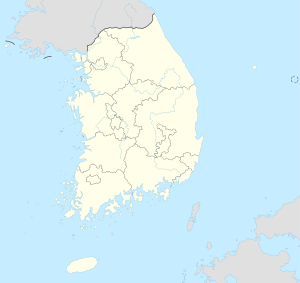Oeam
| Oeam | |||
|---|---|---|---|
| Korean alphabet : | 외암 마을 | ||
| Chinese characters : | 牙山 外 巖 | ||
| Revised Romanization : | Oeam | ||
| McCune-Reischauer : | Oeam | ||
| Basic data | |||
| Province : | Chungcheongnam-do | ||
| Coordinates : | 36 ° 44 ′ N , 127 ° 1 ′ E | ||
| Residents: | 192 | ||
| map | |||
|
|||
Oeam ( Korean 외암 마을 ) is a historic village from the Joseon Dynasty in west-central South Korea .
geography
The village is located around 5.5 km south of downtown Asan ( 아산시 ) in the rural community of Songak-myeon ( 송악면 ), Chungcheongnam-do Province ( 충청남도 ). Cheonan ( 천안시 ), as another larger city, is around 14 km to the northeast and the two-armed reservoir Songakjeosuji ( 송악 저수지 ), whose arms each have a length of around 1.5 km, is 2 km to the southwest.
The village complex is around 820 m long in east-west direction and measures around 320 m at its widest point. Oeam can be reached via the ring road surrounding Asan (Expressway 21), with the exit on the expressway 39 in the direction of Songak-myeon, exit Oeam-ri.
history
In January 2000, the entire village complex was given the status of a historically valuable village by the South Korean government and was registered as an important cultural asset under number 236. On March 11, 2011, the village was included in the so-called tentative list of UNESCO . The Korean government thus underscored its will to have the historic site nominated as a World Heritage Site.
Buildings and village complex
The village has a typical layout of a rural community from the Joseon period (1392-1910). According to oral tradition, the village is said to have been laid out over 500 years ago by Yi Sa-jong ( 이사 정 ), a clan member of the Yi family, who came from Yean and has since developed as a village of this family clan. It has over 80 building complexes. In 2011 the village had 192 inhabitants spread over 69 households, of which 38 households had farms as their source of income.
More than half of the houses in the village are thatched and the land around the property is surrounded by stone walls. Most of the stones had been removed from the fields and used to build the walls. For this reason, the masonry is also made up of stones of different sizes. The fields of the farmers have also been enclosed with stone walls, which distinguishes the village from other comparable village complexes.
Another special feature of the village is the production of Yeonyeopju ( 연엽주 ), a type of wine, the production technique of which has been passed on in the village over generations.
Photo gallery
- Historic village of Oeam
Web links
- Homepage . Oeam Historic Village, March 11, 2011;accessed November 29, 2017(Korean).
- Oeam Village . In: World Heritage Convention - Tentative List . UNESCO, March 11, 2011,accessed November 29, 2017.
Individual evidence
- ↑ 전국 안내 지도 . 우성 지도 , Seoul 1999, ISBN 89-85762-10-9 , pp. 12 ( National Guide Map ).
- ↑ Coordinates and longitudes were partly made using Google Earth Pro version 7.3.0.3832 on November 23, 2017.
- ↑ 외암리 민 . OpenStreetMap , accessed November 29, 2017 (Korean).
- ↑ ÖAM Village: A walk into history . Korea Herald , February 27, 2013, accessed November 29, 2017 .
- ↑ a b c Oeam Village . In: World Heritage Convention - Tentative List . UNESCO, March 11, 2011, accessed November 29, 2017 .
- ↑ ÖAM Folk Village ( 아산 외암 민속 마을 ). Korea Tourism Organization , accessed November 29, 2017 .





